Spectral and Energy Efficiency Trade-Off in UAV-Based Olive Irrigation Systems
Abstract
:1. Introduction
1.1. 5G/6G in Precision Agriculture
1.2. M-MIMO
1.3. Precision Irrigation
1.4. Motivation and Contributions
- Design a network model with a three-layered architecture for a UAV-based olive irrigation system.
- Analytically compute the achievable spectral efficiency as well as the energy efficiency of the studied system when a swarm of single antenna UAVs simultaneously communicate with a ground base station equipped with a large number of antennas.
- Numerically determine the optimal number of ground base station antennas, as well as the optimal number of IoT devices (UAVs and actuators) that should be used to ensure the maximum energy efficiency while guaranteeing a high spectral efficiency.
2. Method
2.1. Architecture of the Proposed UAV-Based Olive Irrigation System
- The topmost layer is the cloud layer, consisting of a cloud storage node and a cloud data center. The cloud layer provides scalability and resilience for storing and processing large amounts of data. It serves as a centralized storage unit for updated information on the behaviors of various IoT devices (UAVs and actuators). Additionally, the IoT devices in the lower layer receive regular updates from the cloud layer, ensuring that their behavior is up-to-date. Additionally, the user/farmer can instantaneously and remotely visualize (via the internet) the information and running activities of the olive farm. The user can also control the UAV movements around the orchard.
- The intermediate layer is called the fog layer, consisting of fog nodes (it can be based on Raspberry Pi, Arduino, or any micro-controller) for data processing and storage. It is designed to provide low latency and efficient processing power to meet the needs of the applications running on the devices in the lower layer. These nodes offer services to nearby IoT devices and maintain timely behavior records. This intermediate layer acts as a bridge between different IoT systems and the cloud layer, thus facilitating the interoperability of IoT systems. A cloud gateway (CG) connects the fog layer to the upper layer. Communication between the fog layer and the lower/upper layer is facilitated through M-MIMO technology (see Figure 2).
- The lower layer, also known as the IoT or smart device layer, consists of drones and actuators. In this layer, drones are equipped with cameras and onboard sensors. Specifically, these vehicles ensure remote sensing (RS), which offers the advantage of collecting vital information on a large temporal and spatial scale (which cannot be achieved with traditional technologies). Indeed, by flying over fields, the drones measure soil conditions, namely temperature, humidity, light, soil moisture, and nutrient levels. UAVs can also monitor crop health, detect anomalies, and respond to all end-user requests. As mentioned earlier, IoT devices in this layer have limited storage and computational capacity. Therefore, UAVs send a substantial amount of collected data to the fog layer to conduct speedy computation and services. Then, according to the obtained results, the fog nodes communicate with actuator devices (placed directly in the soil beside each olive tree) to activate/deactivate the corresponding solenoid valve that irrigates the olive tree.
2.2. Network Model
2.3. Spectral Efficiency
- (respectively, ) is the data sample in uplink (respectively, the total number of samples) for every coherence block;
- represents the signal to interference plus noise ratio (SINR) of the k-th UAV (or the fog device) in uplink of the n-th cell.
- is the data sample in the downlink for every coherence block;
- represents the signal-to-interference plus noise ratio (SINR) of the k-th IoT device in downlink of the n-th cell.
2.4. Energy Efficiency
- denotes the throughput of the proposed system and is measured in bit/s/cell. This throughput can be calculated using the downlink (or the uplink) SE expressions given in the previous subsection;
- denotes the power consumption of the proposed system and is measured in W/cell. This power is equal to the sum of the effective transmit power () and the circuit power (), i.e., . Note that the circuit power is consumed by the transceiver hardware at the GBS and different IoT devices. In this work, we adopt the circuit power model in [31].
3. Results
4. Discussion
- Although M-MMSE combining is optimal, it is not frequently used in the research literature. There are several reasons for this. One is the high computational complexity of computing the inverse MxM matrix, especially when M is large. The complexity is also affected by the need to estimate the channels and acquire the channel statistics of all IoT devices. Another reason is that M-MMSE performance is hard to analyze mathematically, while other schemes can give more insightful closed-form spectral efficiency expressions. A third reason is that receiver combining methods are often developed for single-cell scenarios and then applied heuristically in multi-cell systems.
- Additionally, as mentioned earlier, olive farming at Al Jouf, with an area of 7730 hectares and over 30 million olive trees [28], leads to a massive amount of collected data. Given this, it is essential to deploy real-time control, and data should be protected from unauthorized access or interception.
5. Conclusions
Author Contributions
Funding
Data Availability Statement
Acknowledgments
Conflicts of Interest
References
- Lee, M.; Yoe, H. Analysis of Environmental Stress Factors Using an Artificial Growth System and Plant Fitness Optimization. BioMed Res. Int. 2015, 2015, 292543. [Google Scholar] [CrossRef] [PubMed]
- Yang, X.; Shu, L.; Chen, J.; Ferrag, M.A.; Wu, J.; Nurellari, E.; Huang, K. A Survey on Smart Agriculture: Development Modes, Technologies, and Security and Privacy Challenges. IEEE/CAA J. Autom. Sin. 2021, 8, 273–302. [Google Scholar] [CrossRef]
- Berguiga, A.; Harchay, A. An IoT-Based Intrusion Detection System Approach for TCP SYN Attacks. Comput. Mater. Contin. 2022, 71, 3839–3851. [Google Scholar] [CrossRef]
- Tang, Y.; Dananjayan, S.; Hou, C.; Guo, Q.; Luo, S.; He, Y. A survey on the 5G network and its impact on agriculture: Challenges and opportunities. Comput. Electron. Agric. 2021, 180, 105895. [Google Scholar] [CrossRef]
- Massaoudi, A.; Berguiga, A.; Harchay, A. Secure Irrigation System for Olive Orchards Using Internet of Things. Comput. Mater. Contin. 2022, 72, 4663–4673. [Google Scholar] [CrossRef]
- Sharma, A. MERLIN: Smart Framework for Agriculture in India. In Proceedings of the 2021 International Conference on Information and Communication Technology Convergence (ICTC), Jeju Island, Republic of Korea, 20–22 October 2021; pp. 453–457. [Google Scholar] [CrossRef]
- Mohamed, E.S.; Belal, A.; Abd-Elmabod, S.K.; El-Shirbeny, M.A.; Gad, A.; Zahran, M.B. Smart farming for improving agricultural management. Egypt. J. Remote Sens. Space Sci. 2021, 24, 971–981. [Google Scholar] [CrossRef]
- Valecce, G.; Strazzella, S.; Grieco, L.A. On the Interplay between 5G, Mobile Edge Computing and Robotics in Smart Agriculture Scenarios. In Proceedings of the Ad-Hoc, Mobile, and Wireless Networks: 18th International Conference on Ad-Hoc Networks and Wireless, ADHOC-NOW 2019, Luxembourg, 1–3 October 2019; Palattella, M.R., Scanzio, S., Coleri Ergen, S., Eds.; pp. 549–559. [Google Scholar]
- Naqvi, S.M.Z.A.; Saleem, S.R.; Tahir, M.N.; Li, S.; Hussain, S.; Ul Haq, S.I.; Awais, M. Role of 5G and 6G Technology in Precision Agriculture. Environ. Sci. Proc. 2022, 23, 3. [Google Scholar] [CrossRef]
- Liu, J.; Shu, L.; Lu, X.; Liu, Y. Survey of Intelligent Agricultural IoT Based on 5G. Electronics 2023, 12, 2336. [Google Scholar] [CrossRef]
- Javaid, M.; Haleem, A.; Singh, R.P.; Suman, R. Enhancing smart farming through the applications of Agriculture 4.0 technologies. Int. J. Intell. Netw. 2022, 3, 150–164. [Google Scholar] [CrossRef]
- Marzetta, T.L. Noncooperative Cellular Wireless with Unlimited Numbers of Base Station Antennas. IEEE Trans. Wirel. Commun. 2010, 9, 3590–3600. [Google Scholar] [CrossRef]
- Dala Pegorara Souto, V.; Dester, P.S.; Soares Pereira Facina, M.; Gomes Silva, D.; de Figueiredo, F.A.P.; Rodrigues de Lima Tejerina, G.; Silveira Santos Filho, J.C.; Silveira Ferreira, J.; Mendes, L.L.; Souza, R.D.; et al. Emerging MIMO Technologies for 6G Networks. Sensors 2023, 23, 1921. [Google Scholar] [CrossRef] [PubMed]
- Zhang, F.; Zhang, Y.; Lu, W.; Gao, Y.; Gong, Y.; Cao, J. 6G-Enabled Smart Agriculture: A Review and Prospect. Electronics 2022, 11, 2845. [Google Scholar] [CrossRef]
- Bana, A.S.; de Carvalho, E.; Soret, B.; Abrão, T.; Marinello, J.C.; Larsson, E.G.; Popovski, P. Massive MIMO for Internet of Things (IoT) connectivity. Phys. Commun. 2019, 37, 100859. [Google Scholar] [CrossRef]
- Fang, X.; Zhang, Y.; Cao, H.; Ying, N. Spectral and energy efficiency analysis with massive MIMO systems. In Proceedings of the 2015 IEEE 16th International Conference on Communication Technology (ICCT), Hangzhou, China, 18–20 October 2015; pp. 837–843. [Google Scholar] [CrossRef]
- Zhang, L.; Celik, A.; Dang, S.; Shihada, B. Energy-Efficient Trajectory Optimization for UAV-Assisted IoT Networks. IEEE Trans. Mob. Comput. 2022, 21, 4323–4337. [Google Scholar] [CrossRef]
- Millan, S.; Campillo, C.; Casadesus, J.; Perez-Rodriguez, J.M.; Prieto, M.H. Automatic Irrigation Scheduling on a Hedgerow Olive Orchard Using an Algorithm of Water Balance Readjusted with Soil Moisture Sensors. Sensors 2020, 20, 2526. [Google Scholar] [CrossRef]
- Valente, A.; Costa, C.; Pereira, L.; Soares, B.; Lima, J.; Soares, S. A LoRaWAN IoT System for Smart Agriculture for Vine Water Status Determination. Agriculture 2022, 12, 1695. [Google Scholar] [CrossRef]
- Xue, C.; Feng, Y.; Bai, F.; Liu, T. A Drip Irrigation Remote Control System Using 5G-IoT Technology. In Proceedings of the International Conference on Broadband Communications, Networks and Systems, Virtual Event, 28–29 October 2021; Xiang, W., Han, F., Phan, T.K., Eds.; pp. 182–192. [Google Scholar]
- Zhuang, R.; Manfreda, S.; Zeng, Y.; Su, Z.; Ben Dor, E.; Petropoulos, G.P. Chapter 7—Soil moisture monitoring using unmanned aerial system. In Unmanned Aerial Systems for Monitoring Soil, Vegetation, and Riverine Environments; Manfreda, S., Ben Dor, E., Eds.; Earth Observation; Elsevier: Amsterdam, The Netherlands, 2023. [Google Scholar] [CrossRef]
- Ali, A.; Ali, A.; Abaluof, H.; Al-Sharu, W.N.; Saraereh, O.A.; Ware, A. Moisture Detection in Tree Trunks in Semiarid Lands Using Low-Cost Non-Invasive Capacitive Sensors with Statistical Based Anomaly Detection Approach. Sensors 2023, 23, 2100. [Google Scholar] [CrossRef]
- Navidi, M.N.; Seyedmohammadi, J.; Jalali, S.A.S. Predicting soil water content using support vector machines improved by meta-heuristic algorithms and remotely sensed data. Geomech. Geoeng. 2022, 17, 712–726. [Google Scholar] [CrossRef]
- Cheng, M.; Li, B.; Jiao, X.; Huang, X.; Fan, H.; Lin, R.; Liu, K. Using multimodal remote sensing data to estimate regional-scale soil moisture content: A case study of Beijing, China. Agric. Water Manag. 2022, 260, 107298. [Google Scholar] [CrossRef]
- Ozkan, Z.; Bayhan, E.; Namdar, M.; Basgumus, A. Object Detection and Recognition of Unmanned Aerial Vehicles Using Raspberry Pi Platform. In Proceedings of the 2021 5th International Symposium on Multidisciplinary Studies and Innovative Technologies (ISMSIT), Ankara, Turkey, 21–23 October 2021; pp. 467–472. [Google Scholar] [CrossRef]
- Arza-Garcia, M.; Burgess, A.J. Drones in the Sky: Towards a More Sustainable Agriculture. Agriculture 2023, 13, 84. [Google Scholar] [CrossRef]
- Ahansal, Y.; Bouziani, M.; Yaagoubi, R.; Sebari, I.; Sebari, K.; Kenny, L. Towards Smart Irrigation: A Literature Review on the Use of Geospatial Technologies and Machine Learning in the Management of Water Resources in Arboriculture. Agronomy 2022, 12, 297. [Google Scholar] [CrossRef]
- Jouf, the Olive Oil Capital of Saudi Arabia. Available online: https://www.arabnews.com/node/1963456/saudi-arabia (accessed on 30 April 2023).
- Björnson, E.; Larsson, E.G.; Debbah, M. Massive MIMO for Maximal Spectral Efficiency: How Many Users and Pilots Should Be 532 Allocated. IEEE Trans. Wirel. Commun. 2016, 15, 1293–1308. [Google Scholar] [CrossRef]
- Zappone, A.; Jorswieck, E. Energy Efficiency in Wireless Networks via Fractional Programming Theory. Found. Trends Commun. Inf. Theory 2015, 11, 185–396. [Google Scholar] [CrossRef]
- Yang, H.; Marzetta, T.L. Total energy efficiency of cellular large scale antenna system multiple access mobile networks. In Proceedings of the 2013 IEEE Online Conference on Green Communications (OnlineGreenComm), Piscataway, NJ, USA, 29–31 October 2013; pp. 27–32. [Google Scholar] [CrossRef]
- Li, X.; Bjornson, E.; Larsson, E.; Zhou, S.; Wang, J. Massive MIMO with multi-cell MMSE processing: Exploiting all pilots for interference suppression. Eurasip J. Wirel. Commun. Netw. 2017, 2017, 117. [Google Scholar] [CrossRef]
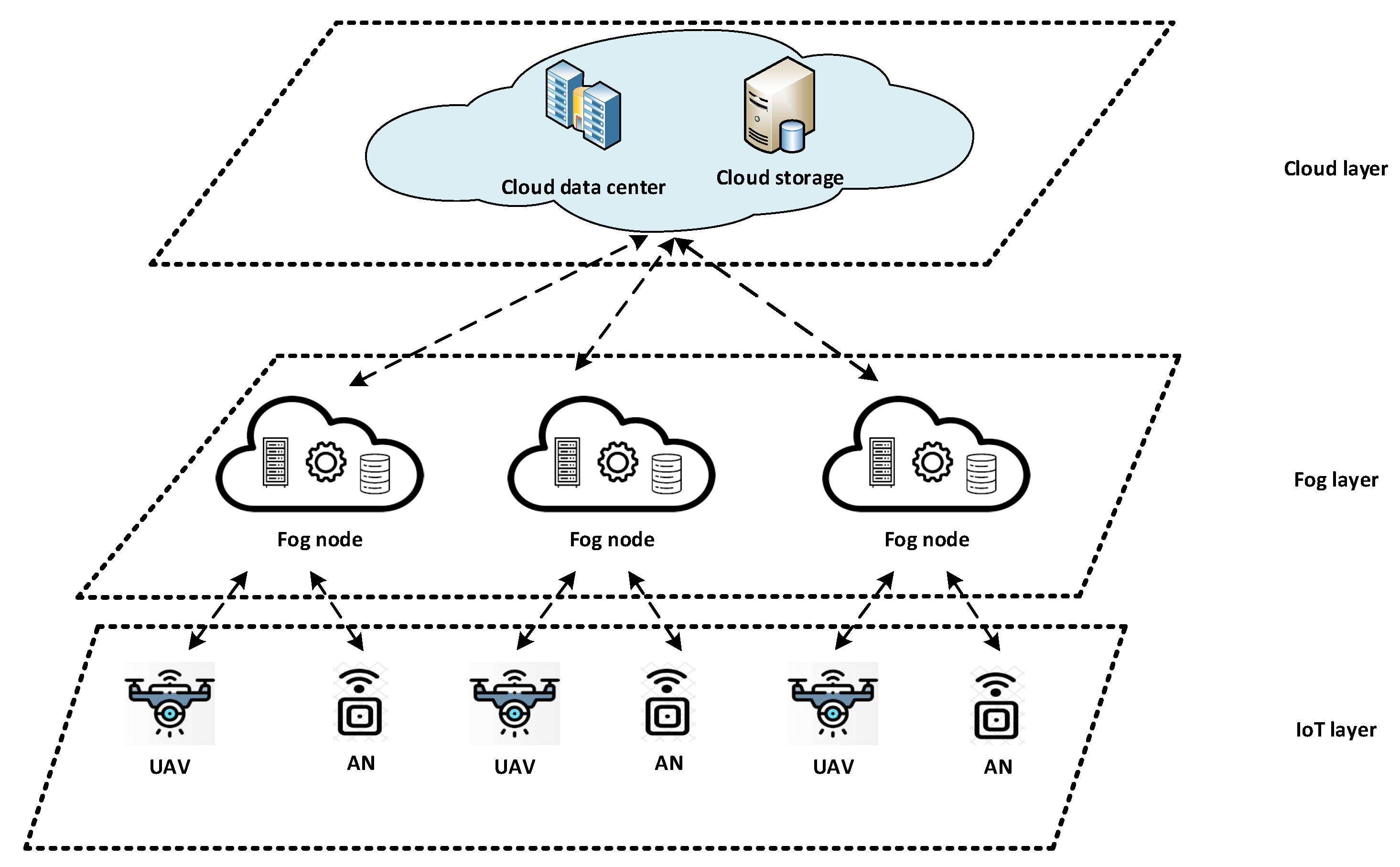
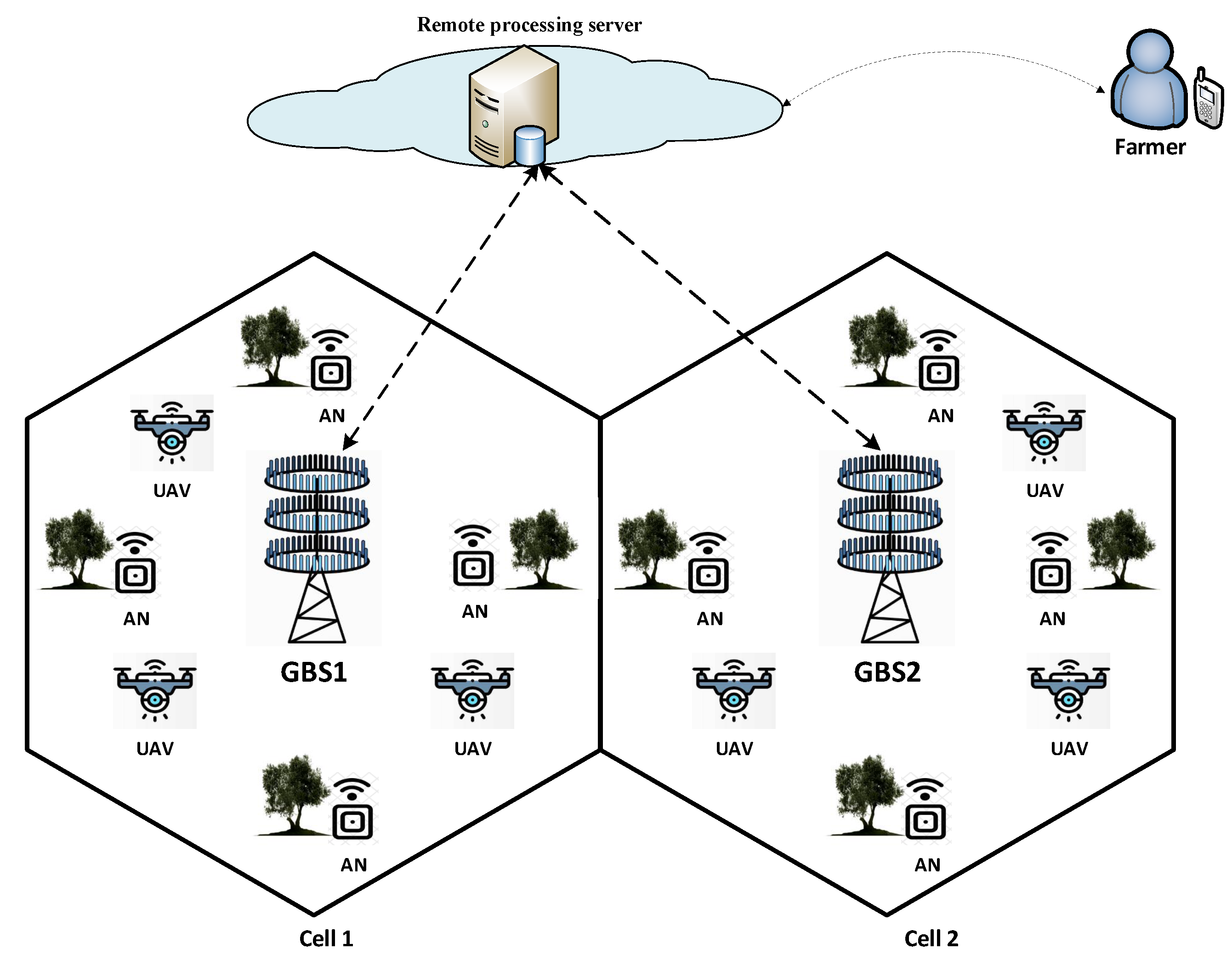

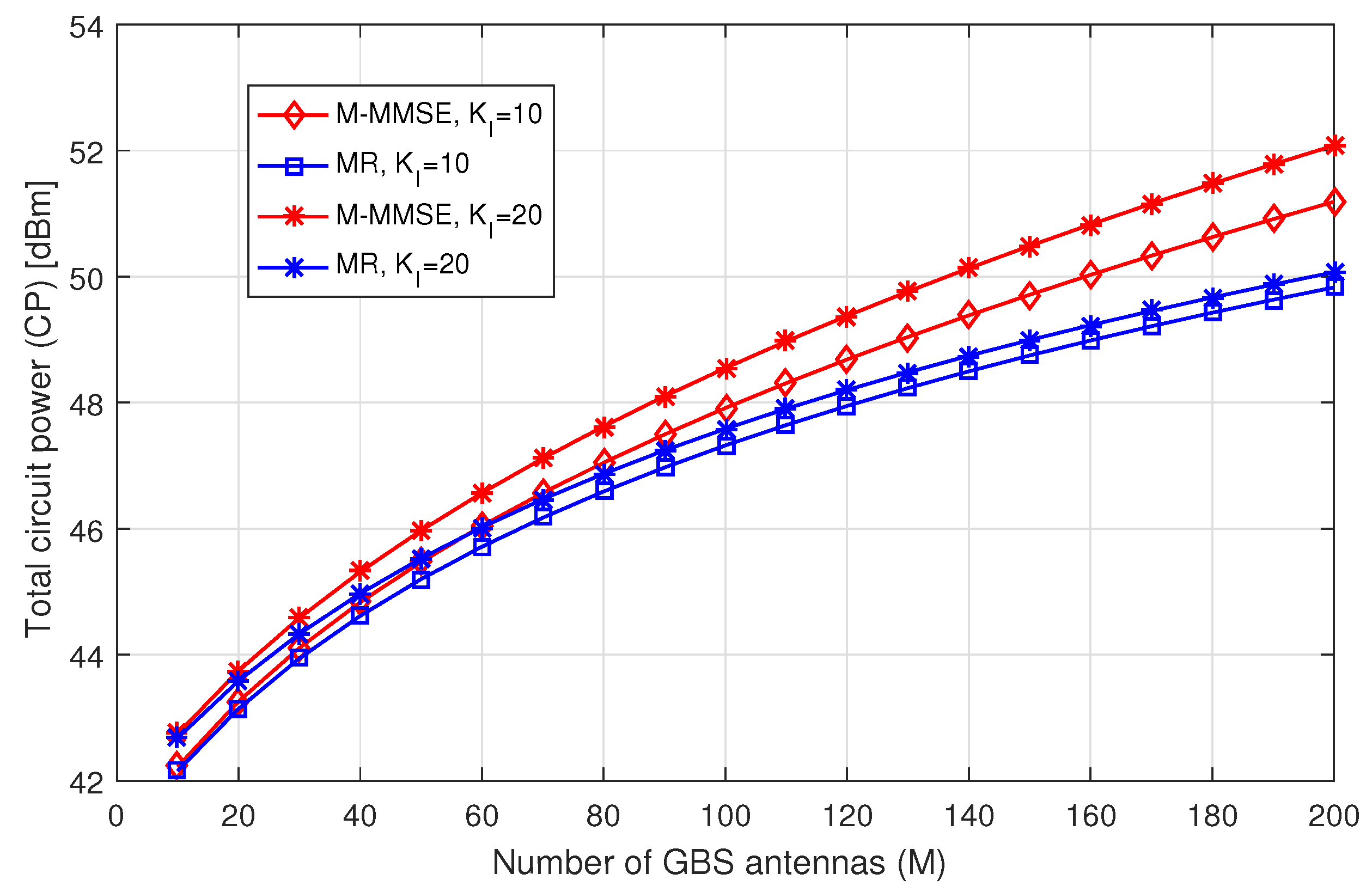
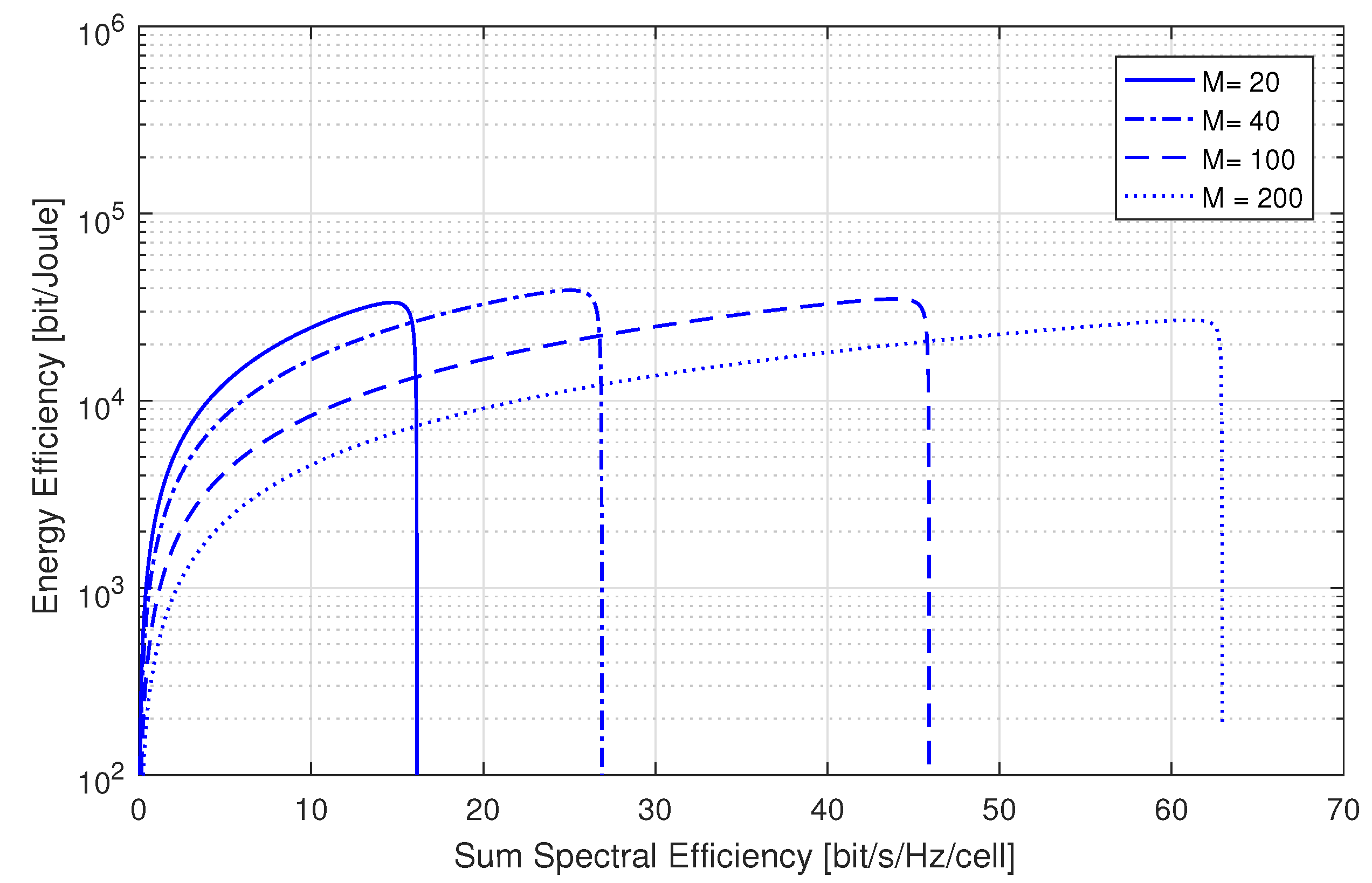
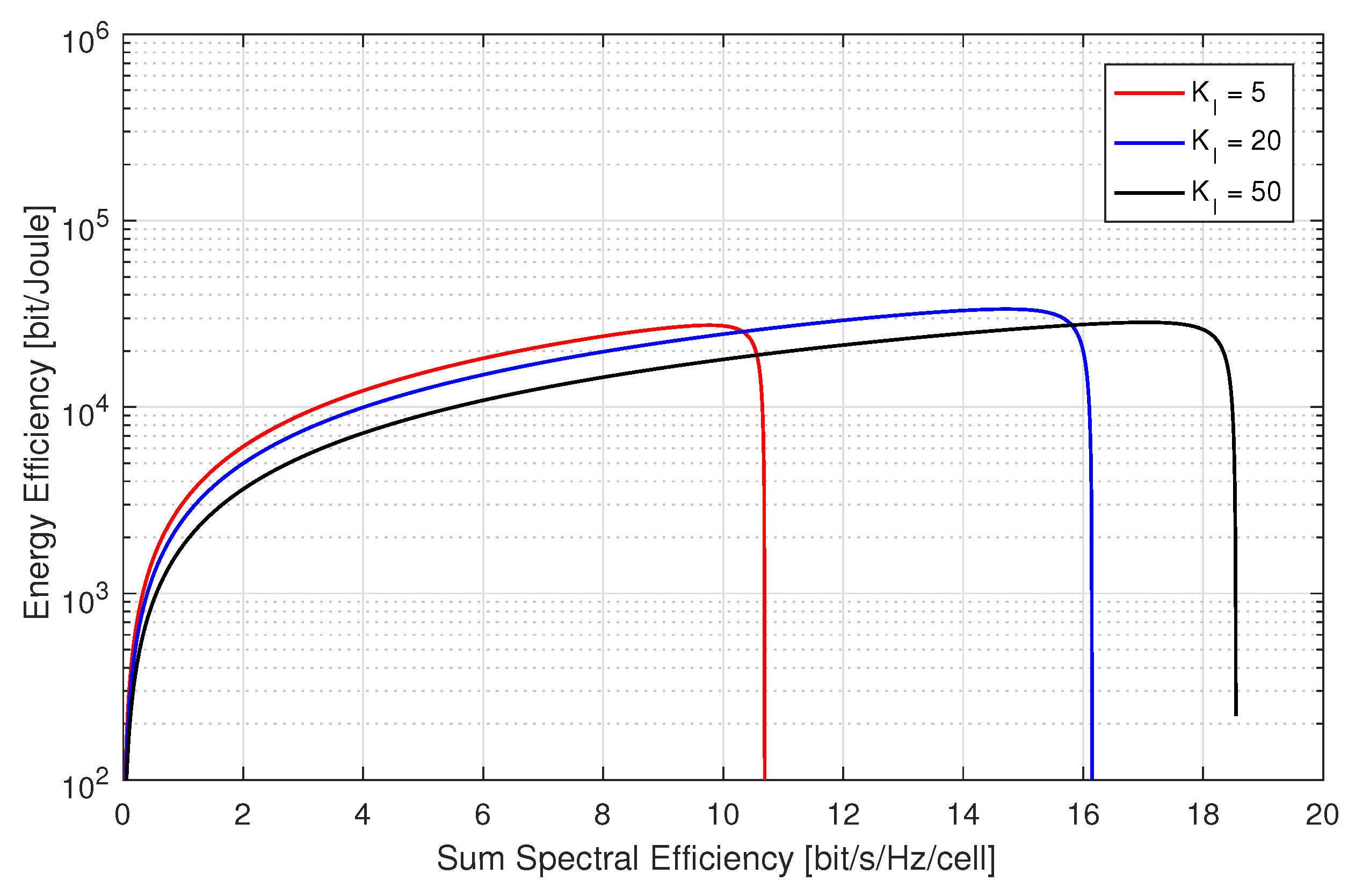

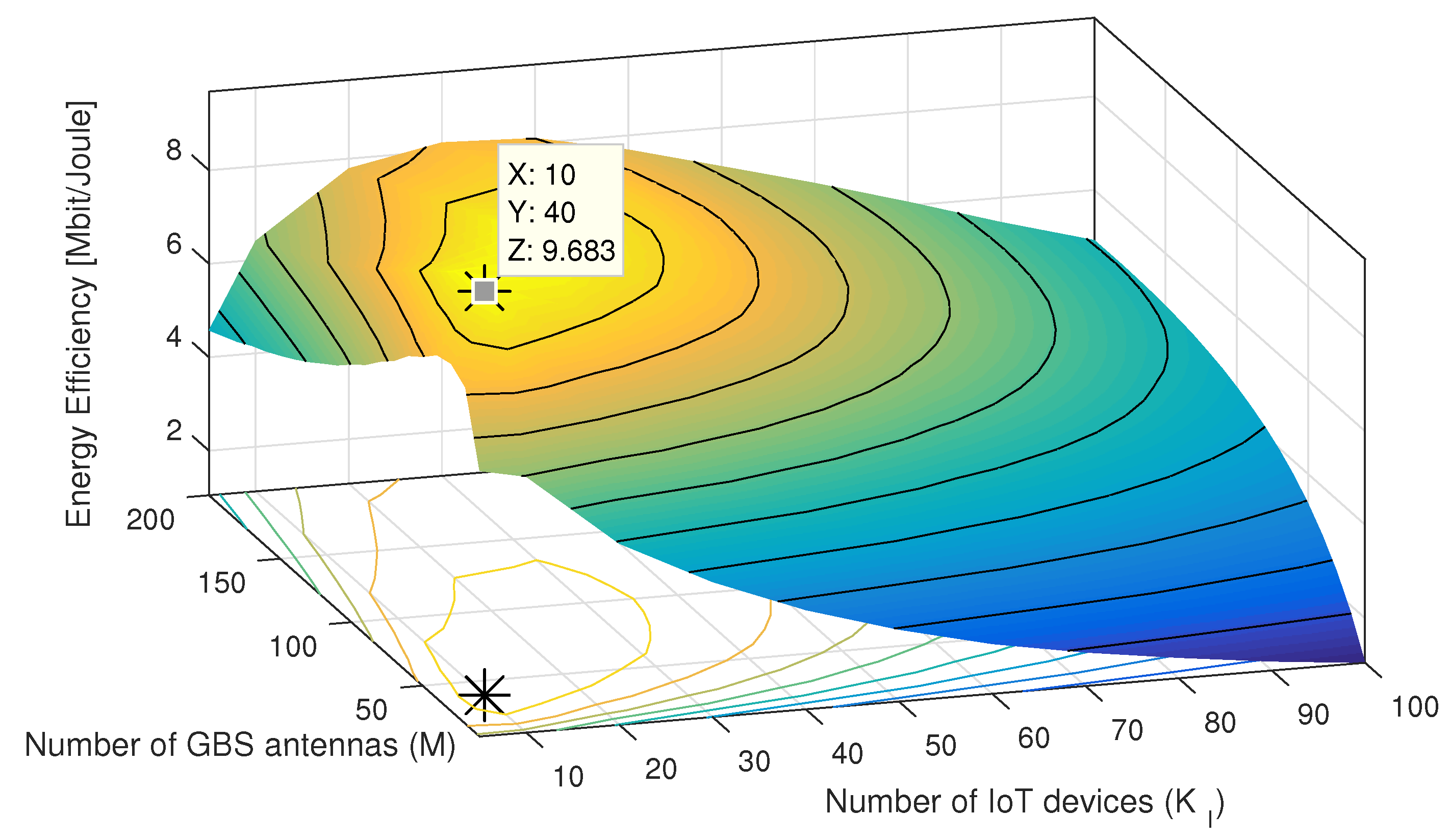
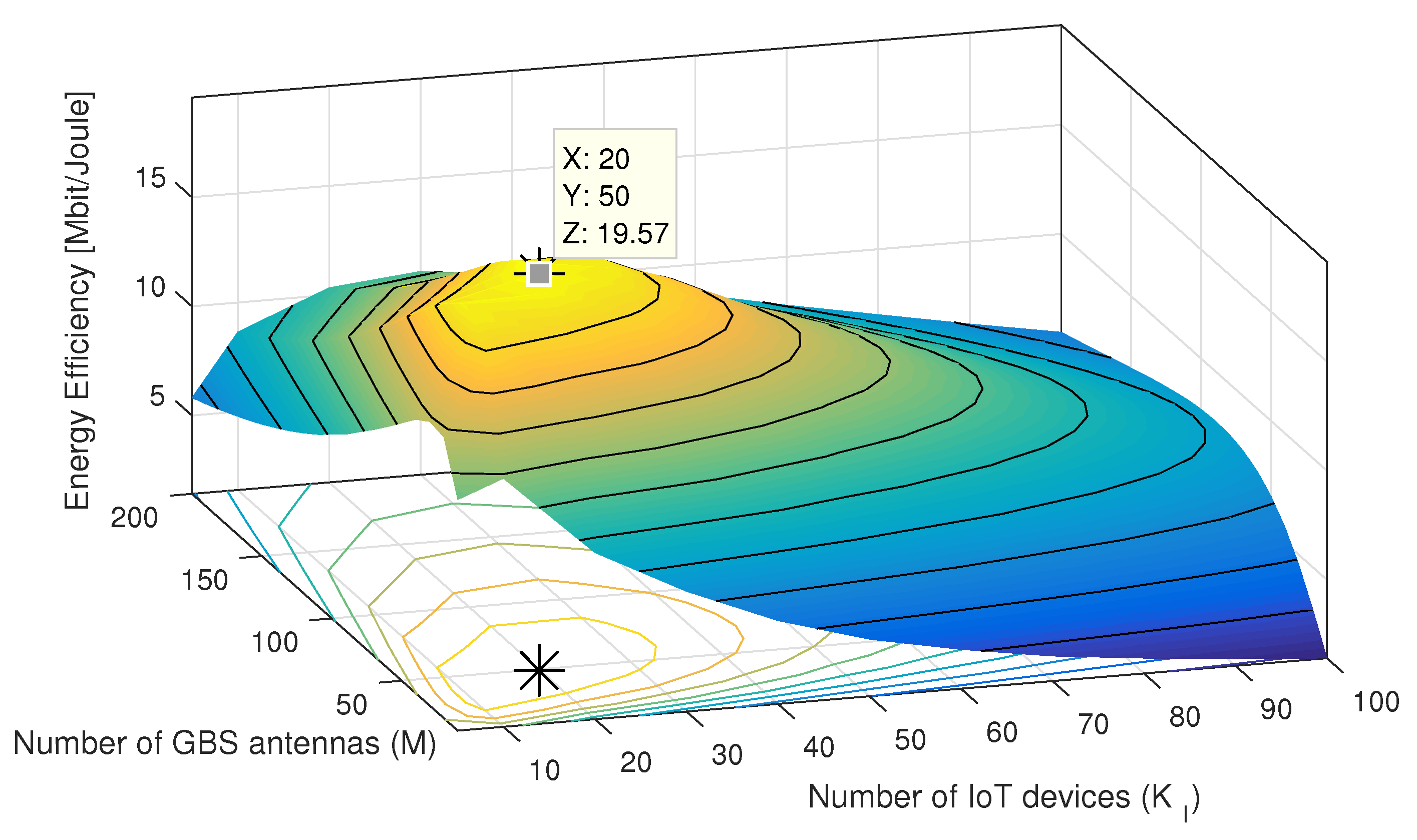
| Parameters | Value |
|---|---|
| Number of cells (L) | 10 |
| Cell radius | 250 m |
| SNR | 0 dB |
| 90 | |
| 90 | |
| 200 |
Disclaimer/Publisher’s Note: The statements, opinions and data contained in all publications are solely those of the individual author(s) and contributor(s) and not of MDPI and/or the editor(s). MDPI and/or the editor(s) disclaim responsibility for any injury to people or property resulting from any ideas, methods, instructions or products referred to in the content. |
© 2023 by the authors. Licensee MDPI, Basel, Switzerland. This article is an open access article distributed under the terms and conditions of the Creative Commons Attribution (CC BY) license (https://creativecommons.org/licenses/by/4.0/).
Share and Cite
Massaoudi, A.; Berguiga, A.; Harchay, A.; Ben Ayed, M.; Belmabrouk, H. Spectral and Energy Efficiency Trade-Off in UAV-Based Olive Irrigation Systems. Appl. Sci. 2023, 13, 10739. https://doi.org/10.3390/app131910739
Massaoudi A, Berguiga A, Harchay A, Ben Ayed M, Belmabrouk H. Spectral and Energy Efficiency Trade-Off in UAV-Based Olive Irrigation Systems. Applied Sciences. 2023; 13(19):10739. https://doi.org/10.3390/app131910739
Chicago/Turabian StyleMassaoudi, Ayman, Abdelwahed Berguiga, Ahlem Harchay, Mossaad Ben Ayed, and Hafedh Belmabrouk. 2023. "Spectral and Energy Efficiency Trade-Off in UAV-Based Olive Irrigation Systems" Applied Sciences 13, no. 19: 10739. https://doi.org/10.3390/app131910739






